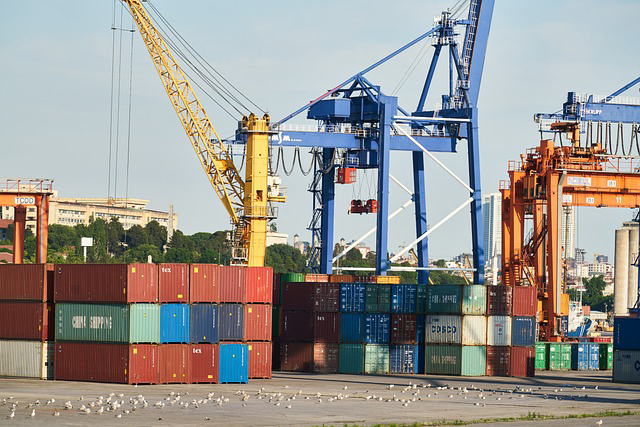How do climate policy and carbon border adjustments affect international trade?

It is important to understand how climate policy affects trade so that international cooperation and standards can be enhanced to ensure that trade is a positive, not a negative, influence on climate change action.
What are the impacts of carbon pricing and border adjustment mechanisms?
There are nearly 70 carbon pricing schemes globally – these capture the costs of emissions in terms of climate change-related loss and damage to human health, the environment, property and so on and tie it to their source through a price, e.g. by applying a tax. However, approaches to pricing vary, and methods to compare their equivalence are only beginning to take form. This has prompted some governments to consider carbon border adjustment mechanisms (CBAMs), which work by imposing a fee on carbon-intensive goods being imported from countries with less stringent climate policy. This can be a way to level the playing field among firms subject to different climate-related regulations and taxes and can disincentivise companies from shifting their production activities to locations where operating costs may be lower due to less stringent climate policies (causing so-called ‘carbon leakage’). However, even if aimed at addressing legitimate environmental concerns such as carbon leakage, such unilateral measures can generate trade tensions and create high administrative costs for firms and governments engaging in international trade. They can further affect trade patterns by incentivising re-shoring (the shifting of production back home to avoid imports) or short-circuiting of supply chains (where less efficient exporters are favoured).
Developing countries in particular have expressed concerns over the potential conflict between such measures and the principle of ‘Common but Differentiated Responsibilities’ (CBDR) included within the Paris Agreement, which recognises that developed countries need to play a greater role in climate action because of their much higher historic emissions and consequent role in temperature rise compared with developing countries. Given that low-carbon technologies are at present mostly owned by developed countries, trade rules that favour ‘cleaner’ exporters imply a transfer of market share from developing to developed economies. In the absence of policies to support these countries’ ability to compete (primarily in terms of access to finance), such measures in isolation can be seen as being in conflict with CBDR. There are high risks associated with innovation in some of the less mature technologies, a lack of certainty and an expectation that this is a ‘subsidies war to the bottom’, which could disincentivise much-needed climate investments; coordination is critical to minimise this uncertainty.
Existing forms of international cooperation on trade and climate
Crucially, global collaboration and cooperation are needed to avoid harmful competition and facilitate large-scale technological breakthroughs, innovation and nurturing of new industries supportive of a low-carbon future. Examples of such cooperation include the World Trade Organization’s (WTO) Agreement on Fisheries Subsidies to prohibit harmful subsidies in support of ocean sustainability, adopted in June 2022. The WTO Committee on Trade and Environment serves as a forum for members to discuss concerns related to climate and exchange their experiences. Negotiations began in 2014 over an Environmental Goods Agreement to address trade barriers and facilitate the development, deployment and diffusion of environmental goods necessary to deliver the transition. However, they ceased in 2017 and have not resumed since.
In the absence of a global agreement on trade and climate, regional trade agreements (RTAs) are stepping up in terms of their focus on climate change. Increasingly, RTAs are committing parties to implementing the Paris Agreement, with some focusing on removing trade and investment barriers to climate-friendly goods, services and technologies. According to the WTO, 64 out of 349 RTAs (18%) currently contain at least one provision referring explicitly to climate change, global warming, reducing greenhouse gas emissions or creating a low-emission economy, and nearly all include at least one environmental provision.
There is increasing support for sustainability-related initiatives among WTO members, including the Trade and Environmental Sustainability Structured Discussions, the Informal Dialogue on Plastics Pollution and Environmentally Sustainable Plastics Trade and the Fossil Fuel Subsidy Reform Initiative. These focus on both tariff and non-tariff policies, but also increasingly on the alignment of low-carbon standards to manage the high transaction costs resulting from varying rules for different markets – something that could be very costly for developing economies in particular. For example, there are currently more than 20 different decarbonisation standards in the steel sector alone, so the WTO has launched the Trade Forum for Decarbonization Standards to promote transparency and coherence in the sector. To drive these efforts in the sustainability space more widely, the International Sustainability Standards Board was announced at COP26.
Further initiatives include a ‘Climate Club’ established by the G7 in 2022, one of the potential functions of which would be to initiate processes for the resolution of trade-related disputes and frictions within the Club to minimise the need to resort to the WTO for such purposes. The Coalition of Trade Ministers for Climate Action was launched at the World Economic Forum in Davos also in 2022, to focus on the nexus between climate and trade.
Complementing these official arrangements is a complex set of private and non-profit sector initiatives operating at the intersection of climate, trade and industry, including the First Movers Coalition and the Mission Possible Partnership, the Smart Freight Centre and the Sustainable Trade Initiative.
This Explainer was written by Danae Kyriakopoulou with Georgina Kyriacou and Natalie Pearson.
See also:
How does trade contribute to climate change and how can it advance climate action?
How does climate change impact on international trade?

